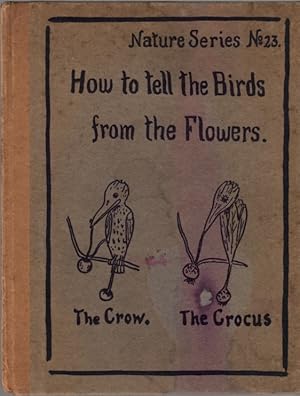How to Tell the Birds from the Flowers, First Edition (3 results)
Product Type
- All Product Types
- Books (3)
- Magazines & Periodicals
- Comics
- Sheet Music
- Art, Prints & Posters
- Photographs
- Maps
-
Manuscripts &
Paper Collectibles
Condition
- All Conditions
- New
- Used
Binding
- All Bindings
- Hardcover
- Softcover
Collectible Attributes
- First Edition
- Signed
- Dust Jacket (1)
- Seller-Supplied Images (1)
- Not Printed On Demand
Seller Location
Seller Rating
-
HOW TO TELL THE BIRDS FROM THE FLOWERS AND OTHER WOOD-CUTS, A REVISED MANUAL OF FLORNITHOLOGY FOR BEGINNERS
Published by Dodd, Mead & Co, NY, 1939
Seller: Larry W Price Books, Portland, OR, U.S.A.
First Edition
Hardcover. Condition: Near Fine. 1st Edition. 49 pp., Illus, Brn Illus Boards with Grn Spine, Interesting Owner inscription ff e.p, else VG+, no DJ, 19th Edition.
-
How to Tell the Birds from the Flowers: A Manual of Flornithology for Beginners; Nature Series No. 23
Published by Paul Elder and Company, San Francisco, 1907
Seller: Clausen Books, RMABA, Colorado Springs, CO, U.S.A.
First Edition
Illustrated Boards. Condition: Very Good. Robert Williams Wood (illustrator). First Edition. Moderately toned, red markings down the end papers, else aged but clean and tight; Character-soiled covers, usual wear to the spine, bumped at the head and foot, lightly bumped corners. 28pp. Size: 12mo - over 6¾" - 7¾" tall. Hardcover.
-
How to Tell the Birds from the Flowers and Other Wood-Cuts: A Revised Manual of Flornithology for Beginners
Published by Dodd, Mead & Company, New York, NY, 1917
Seller: Black Cat Hill Books, Oregon City, OR, U.S.A.
First Edition
Hardcover. Condition: Very Good+. Dust Jacket Condition: Good. First Edition; Twenty-Fourth Printing. Very Good in the scarce, original dust jacket in but Good condition: The Book itself shows moderate shelving wear to the lower extremities and light rubbing to the upper corner tips; the expected light tanning to the text pages due to aging; else flawless; the binding is secure; the text is clean. Free of any creased or dog-eared pages in the text. Free of any underlining, hi-lighting or marginalia or marks in the text. Free of any ownership names, dates, addresses, notations, inscriptions, stamps, plates, or labels. A handsome copy, structurally sound and tightly bound, showing light wear only. Not so very far from 'As New'. The DJ shows sunning to the backstrip (untitled even in the original) , the head of which shows a 1" tear; several tiny nicks and snags to the extremities; mild rubbing to the panels with a touch of consequent soiling to the white background field of the rear panel; the price ($1.50) is intact; mylar-protected. NOT a Remainder, Book-Club, or Ex-Library. 8vo. (7.65 x 6.15 x 0.3 inches). 49 pages. Duotone illustrations throughout. Crimson paper over boards with white titles at the front panel and a cream-toned rear panel; grey cloth backstrip without titles. Crimson front panel on DJ matches that of the book; the rear panel provides authorial information. Language: English. Weight: 4.8 ounces. First Edition (1917) ; 24th Printing (though the copyright pages states '24th Edition'). Hardcover with DJ. Robert Williams Wood (1868 1955) was an American physicist and inventor who made pivotal contributions to the field of optics. He pioneered infrared and ultraviolet photography. Wood's patents and theoretical work inform modern understanding of the physics of ultraviolet light, and made possible myriad uses of UV fluorescence which became popular after World War I. He published many articles on spectroscopy, phosphorescence, diffraction, and ultraviolet light. Wood also authored nontechnical works. In 1915, Wood co-wrote a science fiction novel, The Man Who Rocked the Earth, along with Arthur Train. Its sequel, The Moon Maker, was published the next year. Wood also wrote and illustrated two books of children's verse, 'Animal Analogues' (1908) and this volume, 'How to Tell the Birds from the Flowers', an irreverent parody of the works criticized in the Nature Fakers controversy of the early 20th century, which contested the increasing sentimentality of books about nature for general audiences. The result is a delightful manual of "flornithology," containing humorous rhymes about the similar appearances of various plants and animals. Wood, as mentioned above, was himself a prominent physicist who pioneered working with ultraviolet light, and was more than happy to add some hilarious support to the words of his colleagues in the natural sciences. Particular highlights from his work include comparing an eel to an eel-ephant, an ape to a grape, and a puffin to, well.nuffin. ; Small 8vo 7½" - 8" tall; 49 pages.



